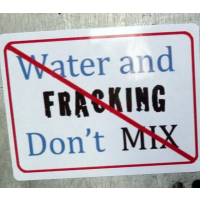Fracking Companies Use “Trade Secret” Loophole to Avoid Chemical Disclosures
 (photo: ecowatch.org)
(photo: ecowatch.org)
Whenever a company reveals what it has been injecting into the earth as part of hyrdraulic fracturing, it’s safe to assume that they have left something out of the disclosure.
In fact, about 60% of the time that fracking chemicals are revealed, a company has withheld some details, according to a review of disclosures by EnergyWire.
The publication found drilling operators kept at least one chemical a secret in 65% of fracking disclosures, citing the need to protect trade secrets.
Among states where fracking is widespread, Utah, which does not require disclosures at all, had the highest rate of companies withholding at least one ingredient (94%). Second was New Mexico, which does have some mandates on publishing fracking chemicals, at 84%, followed by California at 80%.
Companies with the highest tendency to kept chemical details secret were BP America Production Co. and Howell Oil & Gas of Texas, each of which refused to disclose every ingredient used in all of the cases they reported.
“It’s outrageous that citizens are not getting all the information they need about fracking near their homes,” Amy Mall, who tracks drilling issues for the Natural Resources Defense Council, told EnergyWire. “Companies should not be able to keep secrets about potentially dangerous chemicals they’re bringing into communities and injecting into the ground near drinking water.”
The disclosure of chemicals used in fracking has been the subject of an ongoing dispute, with the Obama administration trying to balance the concerns of residents who live near hydraulic fracturing operations and the lure of increasing the domestic production of energy. In May, for example, the Obama administration issued a proposed new rule requiring energy companies that engage fracking on public lands to reveal the toxic chemicals they inject into the ground…but only after drilling is completed.
Some of the more dangerous chemicals used in fracking are hydrofluoric acid (lethal dose: 1.5 grams), sulfuric acid (lethal dose: between one teaspoonful and one-half ounce) and formaldehyde (lethal dose: one ounce.)
-Noel Brinkerhoff, David Wallechinsky
To Learn More:
Hydraulic Fracturing: Two-thirds of Frack Disclosures Omit 'Secrets' (by Mike Soraghan, E&E Publishing)
D-FRAC Hydraulic Fracturing Fluid Disclosure Database (Pivot Upstream Group)
Doctor Challenges Fracking “Trade Secrets” Medical Gag Rule (by Noel Brinkerhoff, AllGov)
Obama Says Frackers Must Reveal Chemicals Used on Public Lands…but only after Drilling is Finished (by Matt Bewig, AllGov)
What Chemicals are Used in Fracking? (by David Wallechinsky, AllGov)
- Top Stories
- Unusual News
- Where is the Money Going?
- Controversies
- U.S. and the World
- Appointments and Resignations
- Latest News
- Musk and Trump Fire Members of Congress
- Trump Calls for Violent Street Demonstrations Against Himself
- Trump Changes Name of Republican Party
- The 2024 Election By the Numbers
- Bashar al-Assad—The Fall of a Rabid AntiSemite






Comments